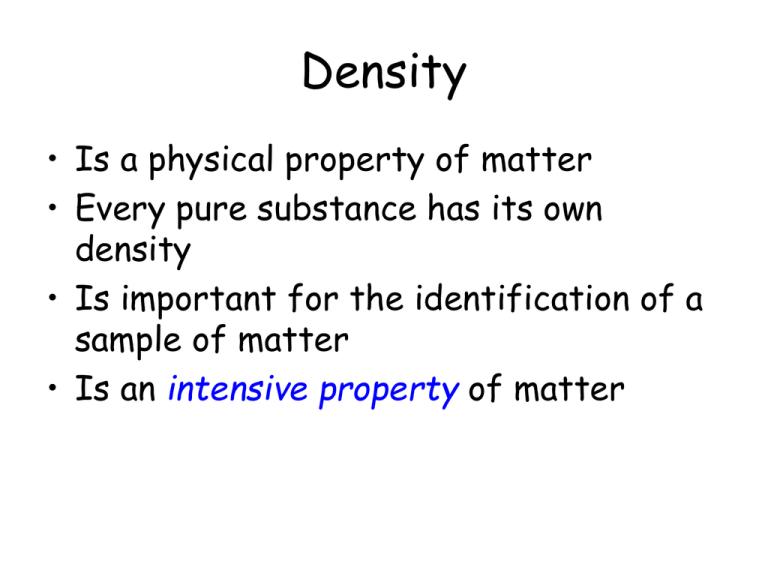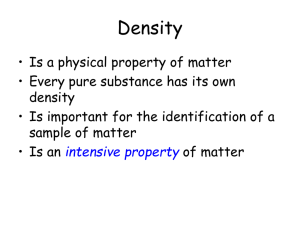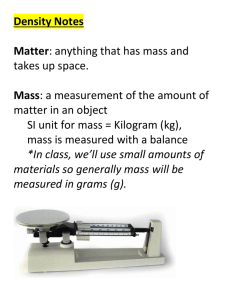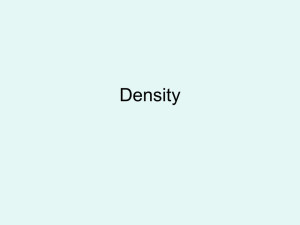Density
advertisement

Density • Is a physical property of matter • Every pure substance has its own density • Is important for the identification of a sample of matter • Is an intensive property of matter Density • Density is defined as mass per unit volume. • The relationship can be written mathematically as: mass density = volume units: solids [ g / cm3 ] liquids[ g / mL] gases [ g / L] OR m d = v Comparison of Densities Each cube represents a volume of 1.00 cm3. The mass of each sample increases while the volume remains constant. Example: • The sample of matter you have has a mass of 3.51 g and occupies a volume of 1.30 cm3. m 3.51 g 3 d= = 2.70g / cm v 1.30 cm 3 EXAMPLE: You need to add 45.0 g of alcohol to a sample. It is difficult to weigh an exact mass of a liquid. It is much easier to measure an exact volume. Using the density of the alcohol (0.789 g/cm3), you can determine what volume you would need to add to your sample so that you would be adding only the 45.0 grams. m 45.0g v= 57.034mL d 0.789g / mL = 57.0 mL in the correct number of sig figs Determining the Volume • In order to figure the density we need to determine the volume: • For regularly shaped objects we use direct measurement: Measuring Volume by Displacement • Used for irregular shaped objects • Select a graduated cylinder large enough to put the object in • Add water and accurately record the initial volume. • SLOWLY add the object to be measured: rubber stopper rock metal cylinder • Read the new level of the water • The water will rise an amount equal to the volume of the object What not to do Here’s what the cylinder should look like Do the math 1 . Original reading of volume 2. Final volume of water 3. This will equal the volume of the object • • 22.5 mL - 17.4 mL = 5.1 mL Therefore, the volume of the object by displacement is 5.1 mL EXAMPLE: An irregularly shaped piece of quartz was place in a graduated cylinder containing 20.45 mL of water. The volume of the ater rose to 24.35 mL. What is the volume of the water? Final volume Initial volume = volume of solid 24.35 mL - 20.45 mL 3.90 mL Classroom Exercises: Blue Block • Mass = 79.4 grams • Volume=29.8 cubic cm. • D = 79.4 g ÷ 29.8 cm3 = 2.66443 = 2.66 g/ cm3 Green Block • Mass= 25.4 grams • Volume=29.8 cubic cm • D = 25.4 g ÷ 29.8 cm3 = .85235 = .852 g/ cm3 Which block is more dense? Cylinder • • • • Radius = 3.5cm Length = 7.25 cm Mass = 32.3 g What is the volume? V = π X radius2 X height π = 3.14 What is the density? Sphere • Diameter = 7.0cm • Radius = 3.5cm • Mass = 32.3 g • What is the volume? V = 4/3 π X radius3 π = 3.14 What is the density? Density • Can also be used as a means of separating components of matter • Ex: if 2 solids of a different density are mixed together, the solid with the greater density will gravitate to the bottom • When a solid object is placed in a liquid that has a great density, the solid object will float. • We will test this hypothesis in lab. Density Gradient THE DENSITY CONCEPT • The picture illustrates a density gradient. • Each item (solid or liquid) is arranged in the cylinder according to its density. • The samples are arranged with the greater densities toward the bottom and the lowest density on the top. The Concept of Density for Liquids and Solids Which kind of matter is more dense? Question for you- Why does ice float? • Solid H2O (ice) is less dense than liquid H2O (water). • Rivers never become completely frozen because as soon as water freezes, it floats up to the surface. • Fish live in the unfrozen, denser liquid water below the layer of ice. • Comparison of: Liquid water Mass = 100 g Volume = 100 mL Density = 1.0 g/mL Ice Mass = 100 g Volume = 110 mL Density = 0.92 g/mL







